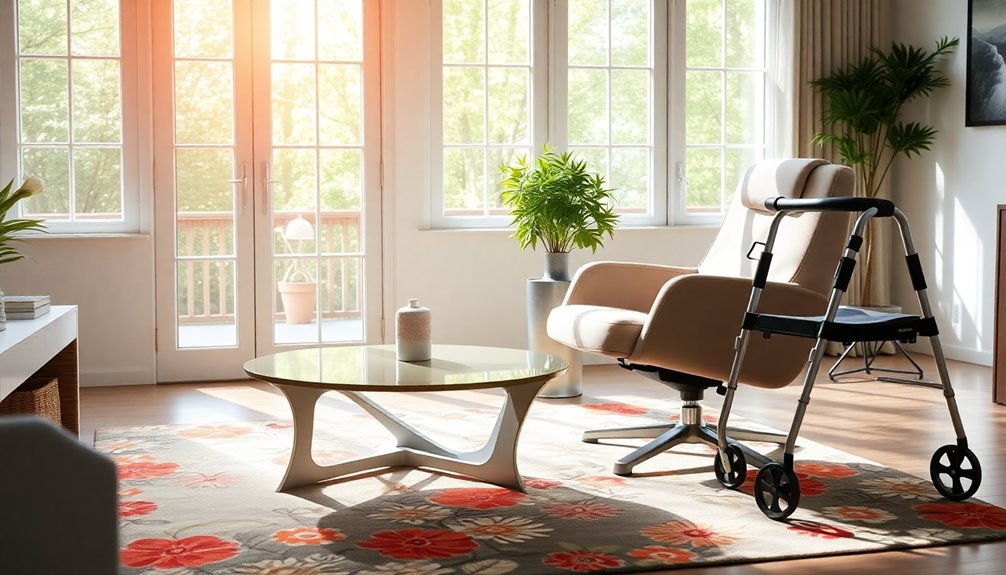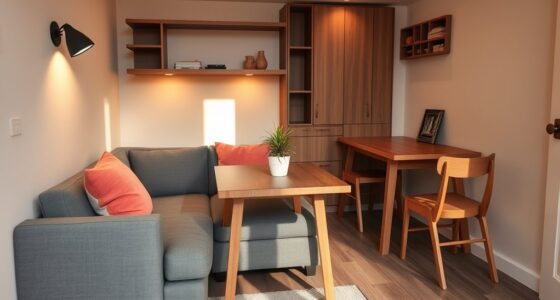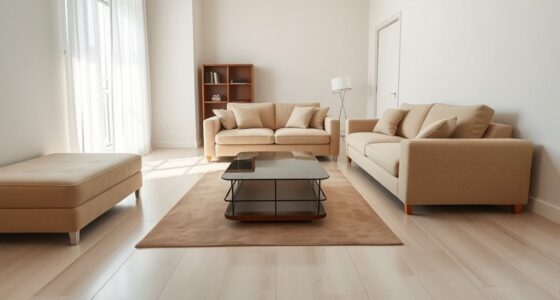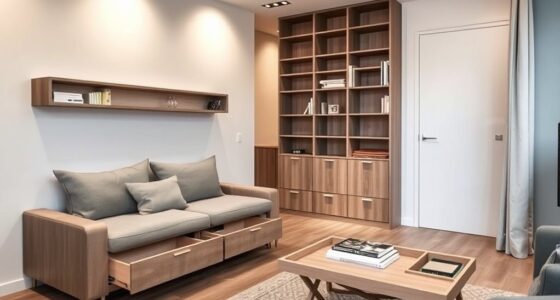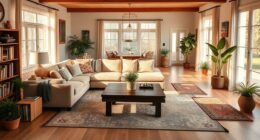Boost mobility for the elderly with smart furniture choices! Opt for ergonomic chairs with lumbar support and adjustable features. Multi-functional pieces, like lift-top tables and storage ottomans, can simplify daily tasks. Choose durable, easy-to-clean materials to support maintenance. Prioritize clear pathways and thoughtful chair placement for accessibility. Finally, consider technology-enhanced solutions to elevate comfort. With these ideas, you're on your way to creating a more accessible and comfortable living space—keep exploring for more inspiration!
Key Takeaways
- Invest in adjustable chairs that ease sitting and standing, providing better support for those with limited strength.
- Utilize multi-functional furniture like lift-top coffee tables and ottomans for added storage and improved posture.
- Choose ergonomic chairs with lumbar support and adjustable heights to promote comfort and correct posture during use.
- Incorporate side tables with wheels for easy repositioning, enhancing accessibility to frequently used items.
- Maintain clear pathways around furniture to facilitate safe navigation for walkers or wheelchairs, preventing potential falls.
Optimize Chair Design for Comfort and Support
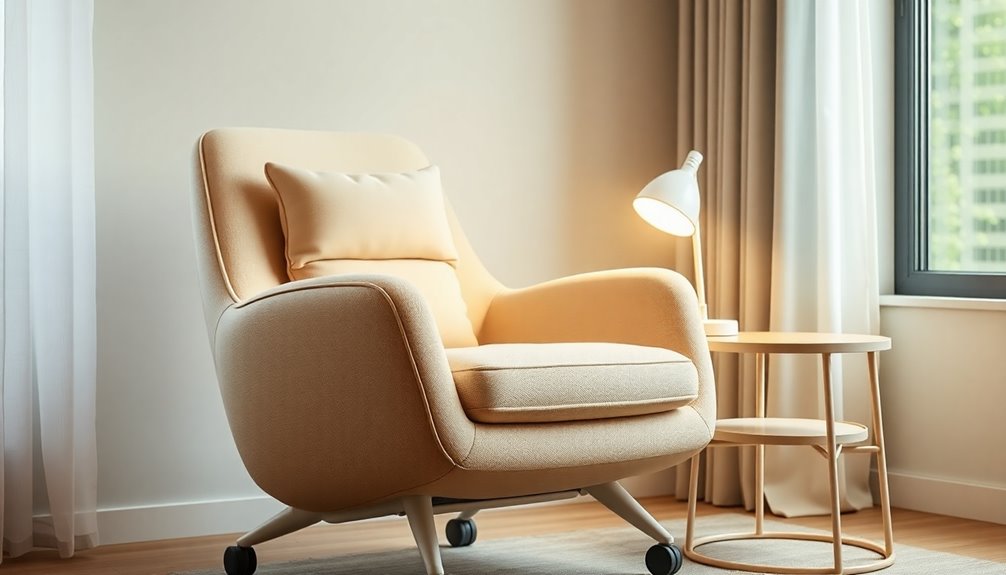
When you're choosing a chair for an elderly loved one, it's vital to prioritize comfort and support.
Look for chairs that offer excellent lumbar and back support to encourage correct posture and reduce discomfort during long periods of sitting. Adjustable heights and supportive armrests make it easier for them to shift between sitting and standing, which is important for their mobility.
Choosing sturdy materials with wide bases and anti-slip features enhances stability, minimizing fall risks. Ergonomic designs with contoured seats and high backs relieve pressure on joints.
Additionally, consider options like lift chairs and adjustable footrests, which can greatly improve usability and accessibility, ensuring your loved one feels secure and comfortable in their seating environment. Safety features in modern electric heated mattress pads can also provide added warmth and comfort during colder months, further enhancing their overall sitting experience.
Prioritize Ergonomic Features in Seating

To guarantee comfort and safety for elderly individuals, prioritizing ergonomic features in seating is essential.
Ergonomic seating for seniors should include high backs and contoured seats to minimize pressure on joints, enhancing comfort during extended use. Adjustable armrests provide better support, making it easier for seniors to shift in and out of the chair.
Sturdy chairs with wide bases and anti-slip features guarantee stability, which can greatly reduce the risk of falls. Additionally, adjustable heights allow for personalized comfort, accommodating various mobility needs.
Select Durable and Easy-to-Clean Materials

When choosing furniture for the elderly, you'll want to prioritize durable materials that can handle everyday wear and tear.
Opt for stain-resistant fabrics and breathable textiles to keep maintenance simple and comfort high.
Material Longevity and Maintenance
Choosing the right materials for elderly-friendly furniture is vital for guaranteeing comfort and longevity. Opting for durable, easy-to-clean materials can make maintenance a breeze. For example, leather and high-quality woven fabrics resist wear and tear, while water-resistant options help manage spills. Additionally, breathable fabrics prevent discomfort during long sitting periods. Regularly maintaining air quality through proper ventilation and cleaning can also contribute to a healthier living environment for the elderly.
| Material Type | Benefits |
|---|---|
| Leather | Durable, easy to clean |
| High-Quality Fabric | Water-resistant, stain-treated |
| Wood/Metal Frames | Stable, withstands regular use |
Regular maintenance, like vacuuming and spot cleaning, is important for preserving the appearance and functionality of your furniture. This way, you guarantee material longevity and keep your living space inviting for years to come.
Stain-Resistant Fabric Options
While selecting stain-resistant fabric options, it's essential to prioritize durability and ease of cleaning, especially for elderly-friendly furniture.
Opt for durable fabrics like leather, microfiber, and high-quality woven materials that resist wear and tear while being easy to maintain. Water-resistant and stain-treated fabrics are particularly effective at managing spills and accidents, keeping your furniture looking clean and presentable.
Additionally, materials with anti-microbial properties enhance hygiene, offering peace of mind for seniors and their caregivers. Choosing fabrics with energy-saving features can also contribute to a more comfortable living environment by ensuring consistent temperature regulation.
Breathable and Comfortable Textiles
Selecting stain-resistant fabrics sets the foundation for creating a comfortable living space, but breathable textiles play an essential role in enhancing overall comfort for the elderly.
When choosing comfortable textiles, consider these key materials:
- Microfiber: Soft, durable, and easy to clean, it's perfect for daily use.
- Leather: Water-resistant and sturdy, it withstands spills while offering elegance.
- High-quality woven fabrics: These allow air circulation, reducing heat buildup for those with sensitive skin. Additionally, ensuring that the textiles are easy to clean can help maintain a hygienic environment, similar to the importance of sanitization in beauty treatments.
Incorporate Stylish and Functional Chairs
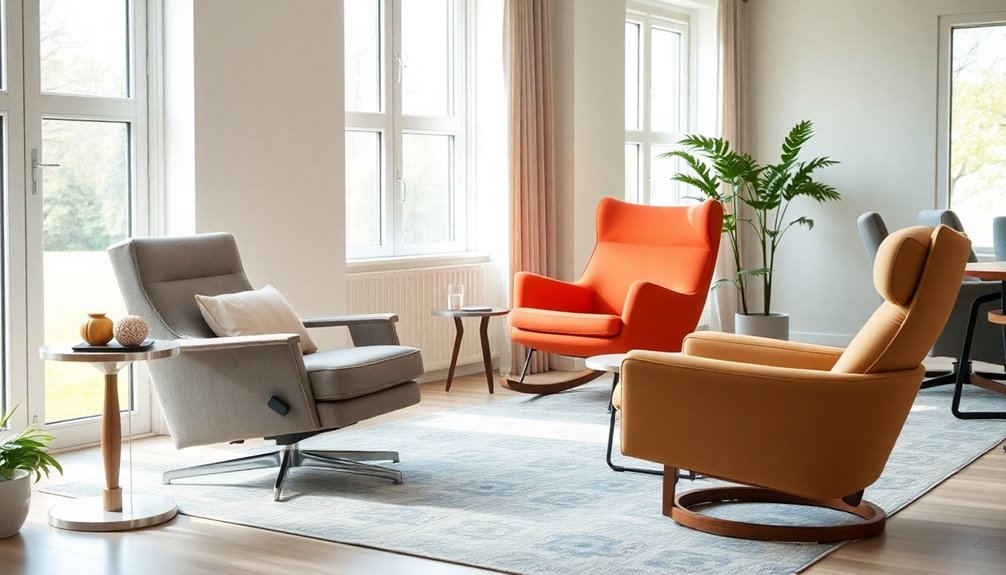
When choosing chairs for the elderly, focus on ergonomic designs that enhance comfort and support.
Consider materials that are durable and easy to maintain, ensuring they stand the test of time.
Also, think about accessibility and placement to create a safe and inviting space for seniors.
Ergonomic Design Features
Ergonomic design features in chairs can greatly enhance comfort and support for seniors, making everyday activities more enjoyable.
If you or a loved one has limited mobility, consider these key elements:
- High Backs and Contoured Seats: These reduce pressure on joints, providing lasting comfort during prolonged use.
- Adjustable Armrests: They offer better support and make shifts in and out of the chair much easier.
- Stylish Designs: Many ergonomic chairs blend seamlessly with contemporary decor, proving that functionality and style can go hand in hand.
Incorporating these features into your living space not only boosts comfort but also promotes independence for seniors, allowing them to navigate their environments with confidence. Additionally, power reclining sofas can provide enhanced relaxation options, making it easier for seniors to find their ideal seating position.
Material Durability Considerations
Durability plays an essential role in choosing chairs for the elderly, ensuring they withstand daily use without sacrificing style. When selecting chairs, look for durable materials like leather, microfiber, and high-quality woven fabrics. These fabrics not only offer functionality but also enhance accessibility by managing spills and accidents with water-resistant features. Breathable materials like mesh keep you comfortable during prolonged sitting. Pair these with robust chair frames made from solid wood or metal for stability and a modern touch. Additionally, consider chairs that incorporate features to consider for improved comfort and usability.
| Material Type | Benefits |
|---|---|
| Leather | Elegant, easy to clean |
| Microfiber | Soft, stain-resistant |
| Mesh/Cotton Blends | Breathable, heat-reducing |
Choose wisely to blend style with practical needs!
Accessibility and Placement Tips
To create a comfortable and accessible living space for the elderly, it's crucial to thoughtfully consider chair placement and design.
Prioritizing functionality while keeping aesthetics in mind is key to Aging in Place. Here are some accessibility and placement tips:
- Keep pathways clear: Make sure chairs don't block walkways, making navigation easy for walkers or wheelchairs.
- Position for access: Place chairs near tables or shelves for easy access to drinks and books.
- Allow space for mobility devices: Guarantee there's enough room around chairs to accommodate walkers or wheelchairs, preventing falls.
- Incorporate technology: Consider using wearable technology that enhances safety and peace of mind for seniors while they move about their living space.
Use Multi-Functional Furniture for Versatility

As you consider your living space, incorporating multi-functional furniture can greatly enhance both versatility and comfort for elderly individuals.
Pieces like ottomans that double as storage solutions help reduce clutter, providing easy access to items and improving mobility. Lift-top coffee tables allow seniors to reach items without bending down, which supports better posture and reduces back strain.
Sofa beds maximize space in small areas, offering extra sleeping options while maintaining a comfortable seating area. Additionally, side tables with built-in wheels enable easy repositioning, allowing seniors to adjust their surroundings without heavy lifting.
Finally, adjustable height furniture, such as dining tables, accommodates various mobility devices, ensuring a welcoming environment for everyone. Moreover, these furniture choices can create a sense of calm through organized environments, enhancing emotional well-being for seniors.
Implement Functional Chairs as Design Elements
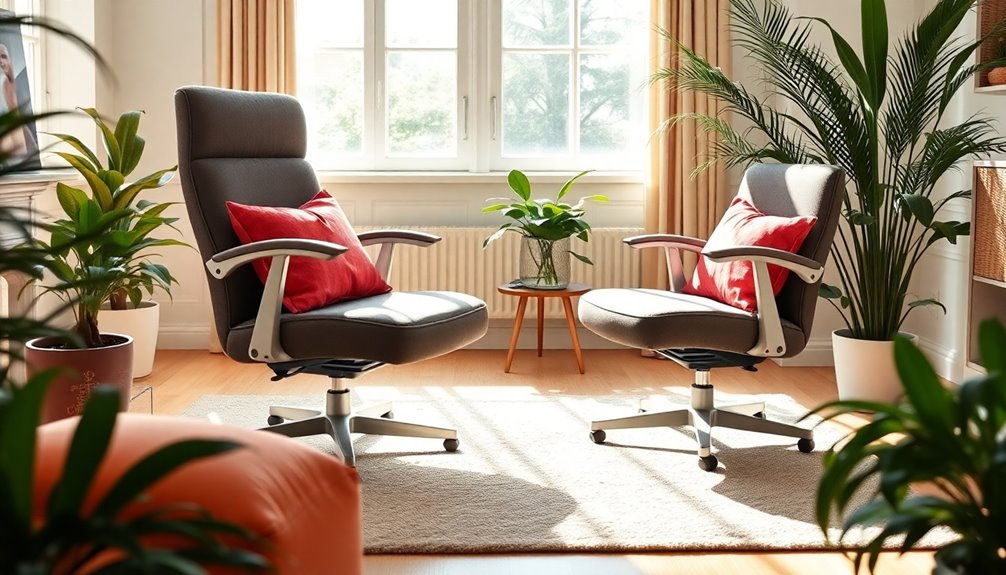
When choosing chairs for your space, consider stylish ergonomic options that offer both comfort and support.
You can play with versatile colors and patterns to match your home's decor while adding a personal touch.
Plus, look for space-saving designs that maximize functionality without sacrificing aesthetics.
Stylish Ergonomic Chair Options
While finding the perfect chair for seniors, you can prioritize both style and comfort by choosing ergonomic options that enhance any living space.
Stylish ergonomic chairs not only provide essential support but also add a touch of elegance.
Here are three features to take into account:
- Adjustable Armrests: These promote proper posture and reduce joint pressure, making it easier for seniors to sit comfortably.
- Sturdy Materials: Opt for wood or metal frames for stability and durability, ensuring safety as individuals sit and stand.
- Breathable Fabrics: Trendy upholstery options enhance comfort by reducing heat buildup and allow for easy cleaning, making everyday use practical. Additionally, ensuring a safe sleep environment can contribute to overall well-being, especially for those who may struggle with mobility.
Versatile Color and Patterns
Functional chairs can be more than just supportive seating; they can also serve as key design elements in your home. By blending aesthetics with practicality, these functional chairs can transform your home into a stylish yet comfortable space for elderly users.
Opting for minimalist designs in neutral colors creates a calming environment, essential for enhancing comfort. Clean lines and geometric patterns complement modern interiors, ensuring your furniture remains both chic and functional.
If you want to add personality, consider bright upholstery or bold patterns as statement pieces. Coordinating pillows or throws can further enhance the visual appeal, making your seating area not only inviting but also supportive for those who need it most. Additionally, ensuring that the furniture is designed for mental clarity can help create a more serene living space for elderly individuals.
Space-Saving Design Solutions
Incorporating space-saving design solutions can dramatically enhance the comfort and functionality of a home for the elderly.
Functional chairs can be both practical and stylish, making your space more inviting. Here are some design tips to reflect upon:
- Choose chairs with minimalist aesthetics that blend seamlessly into modern interiors.
- Opt for neutral colors and clean lines for versatility across different home styles.
- Use bold upholstery or unique patterns to create statement pieces, adding personality without sacrificing functionality.
Enhance Accessibility With Thoughtful Chair Placement

To enhance accessibility for the elderly, thoughtful chair placement is essential in creating a safe and inviting living space.
Position chairs to prioritize open pathways, ensuring at least 36 inches of space for wheelchair or walker access. This prevents mobility restrictions and helps prevent falls.
Place chairs near commonly used items like tables or shelves, making it easier for elderly individuals to reach drinks or books.
Allow sufficient space around chairs for mobility aids, ensuring smooth navigation and reducing the risk of accidents.
Additionally, be mindful of chairs with wheels; position them strategically to avoid blocking walkways.
Create Clutter-Free Living Spaces
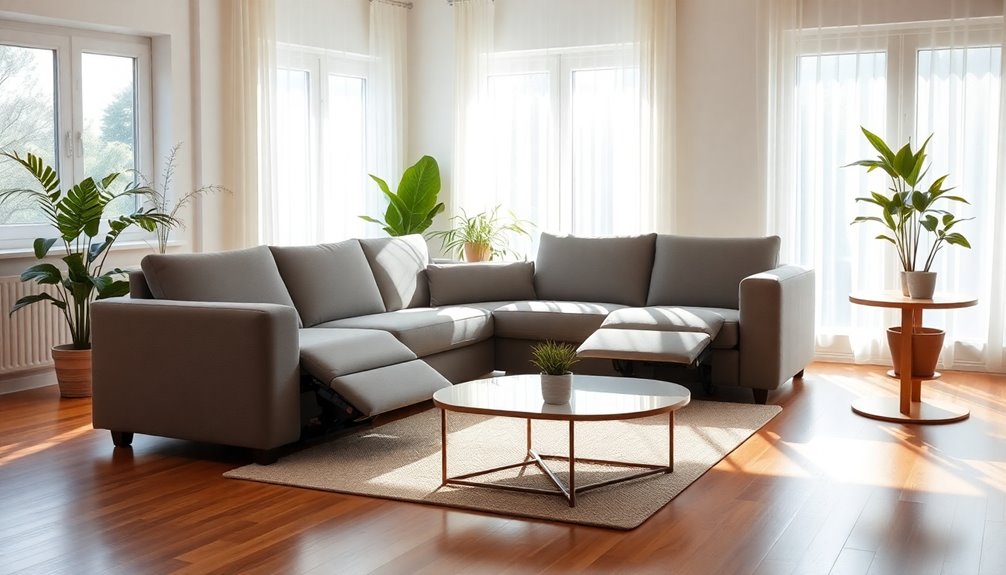
Creating a clutter-free living space not only enhances the aesthetics of a home but also greatly improves safety and mobility for the elderly.
By maintaining clear pathways, you reduce tripping hazards and make navigation easier. Here are three effective strategies to achieve this:
- Regularly declutter: Set aside time weekly to remove unnecessary items and keep essential ones easily accessible.
- Use smart storage solutions: Invest in shelving, baskets, and cabinets to elevate items off the floor and minimize clutter.
- Arrange furniture thoughtfully: Guarantee pathways are at least 36 inches wide to accommodate walkers and wheelchairs comfortably.
Utilize Adjustable Furniture for Flexibility
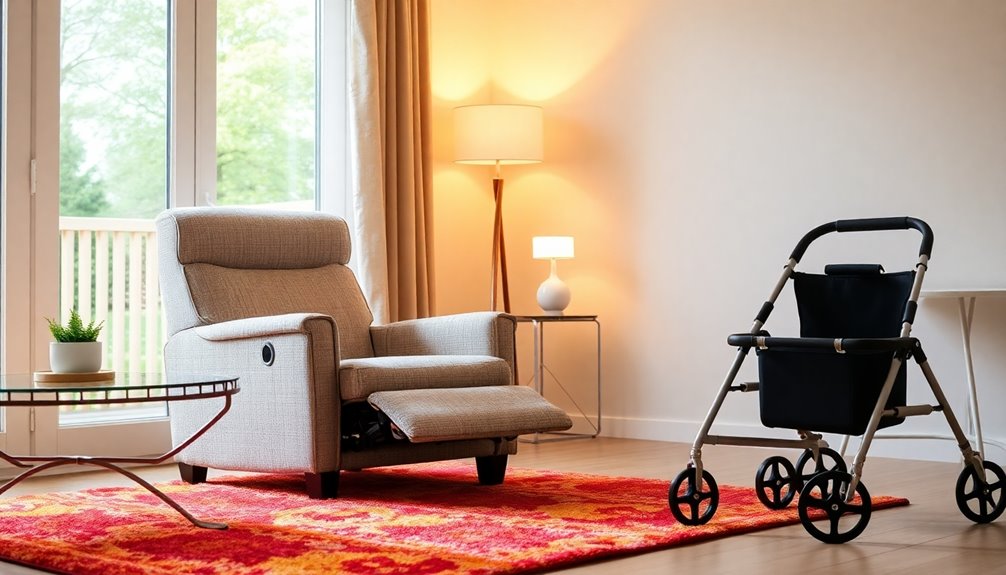
Adjustable furniture offers a practical solution for seniors seeking comfort and ease in their living spaces. By customizing your environment, you can enhance your ability to live independently. Height-adjustable tables and desks are perfect for tailoring workspaces, while chairs with adjustable heights and armrests make adjustments smoother, reducing fall risks.
| Type of Adjustable Furniture | Benefits | Ideal For |
|---|---|---|
| Height-Adjustable Tables | Customizable workspace | Dining or working |
| Adjustable Beds | Various sleeping positions | Joint pain relief |
| Adjustable Chairs | Easier sitting/standing | Limited strength |
| Modular Furniture | Personalized layouts | Mobility aids access |
| Lift Mechanism Furniture | Simplifies getting in/out | Balance support |
Investing in these pieces can greatly enhance your mobility and comfort.
Consider Technology-Enhanced Comfort Solutions
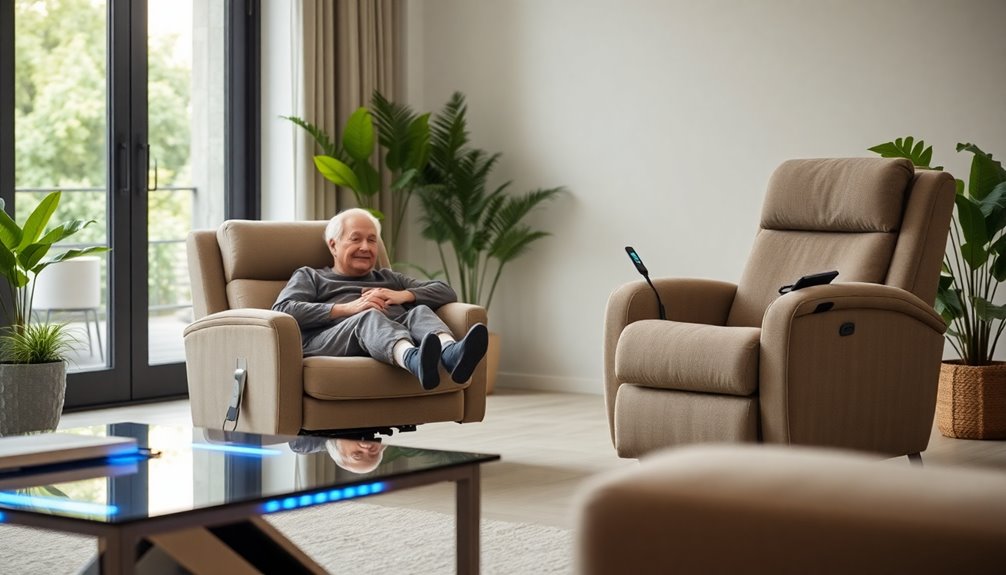
Incorporating technology into your furniture can greatly enhance comfort and accessibility. Smart chairs equipped with adjustable height and lumbar support features allow you to customize your seating position effortlessly.
Plus, ergonomic furniture designs with integrated technology promote better posture and comfort. Here are three key features to contemplate:
- Reclining lift chairs: These come with built-in heating and massage functions, easing joint pain and promoting relaxation.
- Voice-activated controls: Adjust your seating or call for assistance without reaching for controls, enhancing your independence.
- Posture monitoring sensors: These alert you when adjustments are needed, preventing discomfort and encouraging proper alignment.
Frequently Asked Questions
What Do the Elderly Need Most?
The elderly need comfort, support, and safety in their daily lives.
You'll want to guarantee they've furniture with proper lumbar support and adjustable heights to make sitting and standing easier.
Stability is key, so look for chairs with wide bases and anti-slip features.
Ergonomic designs help reduce joint pressure, while accessible storage solutions keep spaces clutter-free and safe.
Thoughtful furniture placement creates clear pathways, enhancing mobility and usability for a smoother experience.
How to Arrange Furniture for the Elderly?
"Home is where the heart is," so make it safe and accessible.
To arrange furniture for the elderly, guarantee wide pathways of 36 inches to accommodate mobility aids. Position seating near essential items to reduce walking distance. Keep furniture spaced apart for easy navigation, and choose lightweight pieces that can be moved as needed.
Consistent furniture heights will help with standing and sitting, promoting comfort and safety throughout their living space.
What Is the Most Desirable Home Design for Aging in Place?
The most desirable home design for aging in place focuses on accessibility and safety.
You'll want wide doorways and an open floor plan to make navigation easier. Opt for non-slip flooring to prevent trips and falls.
In the bathroom and kitchen, consider features like zero-threshold showers and lowered countertops.
Incorporating grab bars and lift chairs can enhance comfort and security, while custom storage solutions keep your space organized and clutter-free.
What Is the Best Chair Height for Seniors?
Imagine a gentle wave, rising just high enough to cradle you comfortably.
The best chair height for you, as a senior, generally falls between 17 to 19 inches off the floor. This height eases your shifts from sitting to standing, reducing strain on your knees and hips.
Measure your leg length to find the perfect fit, or consider adjustable options to enhance comfort and stability, ensuring each moment spent seated is a pleasure.
Conclusion
By incorporating these clever furniture ideas, you can truly make a difference in the lives of the elderly. It’s all about creating spaces that are not just functional but also comfortable and stylish. Remember, a little thought goes a long way. With the right choices, you won’t just improve mobility; you’ll also help them feel at ease in their own homes. So, let’s get the ball rolling and transform those living spaces into havens of comfort! Consider incorporating spacesaving furniture for seniors, which maximizes utility without compromising on style. These innovative designs can make it easier for elderly individuals to navigate their homes while providing essential storage solutions. Additionally, adding personal touches, like favorite photos or soft textiles, can further enhance their comfort and sense of belonging.
